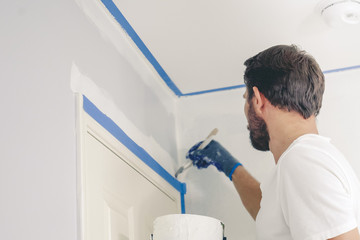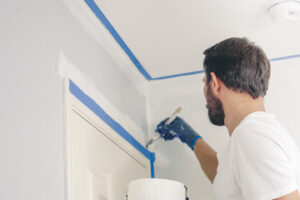House Painter job does more than make your home look good – it protects the structure from wind, water, and other weather threats. But whether you’re doing the work yourself or hiring a professional, there are some things to remember.
It’s important to prepare the surface before you apply paint. This includes cleaning, sanding, and priming.

Painting is integral to home renovation, but proper surface preparation is essential for a quality paint job. Many must complete this step, costing themselves time, money, and sub-par results.
House painting has been a common practice for tens of thousands of years. The oldest cave paintings date back 40,000 years to the Ice Age, and people have adored their homes with colors since then. The skills of the house painter have evolved to keep up with technology, but it’s still a labor-intensive, skilled craft that requires the right tools and techniques.
Before painting, cleaning the exterior walls thoroughly to remove dirt and grime is important. This will ensure the new paint will adhere to the surface and last longer. This process can be done using a power washer, or it may be necessary to scrub the stains with a wire brush and detergent solution. After cleaning the surfaces, they are required to dry completely.
It is also important to determine if the surface is damaged or worn and take measures to repair any problems before the painting starts. This will save the homeowner a lot of headaches in the long run and make the finished product look better and last longer.
Some homeowners choose to do their house painting, while others rely on the services of professional house painters. Whether a homeowner is doing the painting himself or hiring a professional, he should familiarize himself with all the different terms and steps involved in the project. This will help him know exactly what to expect and avoid surprises.
For example, it is important to understand the difference between primer and paint. While primer is not technically a type of paint, it’s necessary in many painting projects. It helps the paint adhere to the surface and ensures that the color comes true on the final coat of paint. Primer can be water- or oil-based and should match your paint color.
Whether painting a new house or doing an exterior repaint, surface preparation is critical for a successful and long-lasting paint job. Taking the time to prep surfaces adequately will ensure the proper adhesion of the new paint and will prevent the problems associated with peeling and blistering.
Prepping the surface will usually involve scraping and sanding. Loose paint should be removed, and any damage to the shell should be repaired. Cracks and crevices should be filled with good caulking. Once the surface is prepared, it should be primed. Primer is necessary to improve adhesion and help the new coat of paint hold up longer. Several different primers are available, and the type used will depend on the surface material. A latex primer will work well on drywall and plaster, but other types of primer may be more effective for wood, concrete, and stucco.
Lastly, the surface should be washed to remove any dirt and debris. Then, any areas that will be painted should be cleaned with a mild cleanser and then rinsed thoroughly. The surface should then be allowed to dry completely before it is painted.
The next step is to choose the color of the paint. Many will apply a few color swatches to the surfaces to see how they look under different lighting conditions. Once the color is chosen, it is important to get all of the supplies and equipment ready to begin. This may include renting or purchasing a ladder and scaffolding, securing any needed safety gear, and brushing up on your safety knowledge.
Moving any furniture or other items out of the way and covering anything you do not want to get paint on, such as carpeting, flooring, electrical outlets, or light fixtures, is also a good idea. It is also a good idea to cover any plants and shrubs around the house, but remove these covers at the end of each day so that the paint does not touch them. If the job is extensive, start at least one section at a time and take breaks.
Painting a house does not just make it look better; it also protects it from wind and water damage, mold, mildew, insects, and other elements that may cause more serious problems. Regularly repainting the exterior of a house can greatly increase its lifespan and reduce the need for expensive repairs. However, some key factors should be considered before choosing a specific color and beginning the project.
Before applying the paint, removing any loose or flaking material is a good idea. This can be done by scraping or sanding the area to be painted. Once the surface is clean, a primer can be applied. The primer can help prevent the new coat of paint from adhering to the surface and provide a smoother finish for the final product.
Then, the final coat of paint can be applied. They use the first coat while the weather is still warm to dry before the cold temperatures arrive. It is also a good idea to choose a sunny and clear day so that rain or humidity will not affect the new coat of paint.
When choosing the color, it is important to consider the home’s style and the surrounding landscape. For example, if the house is situated on a hill, a dark color will blend better with the natural surroundings than a lighter color. It is also a good idea to match the color of the roof and trim to the rest of the house, as this will create a cohesive look.
Quality paint is a good idea, as it will last longer and be more durable than cheap paint. It is also a good idea to purchase extra paint, as it can be useful for touch-ups or in the event of an accident.
Painting a house can be difficult and time-consuming, but it can also be very rewarding. Hiring professional painters is a good idea if you are uncomfortable doing the job yourself. A crew of painters can often complete in one or two weeks what might take a do-it-yourselfer several weeks or months to accomplish.
Whether it’s an interior or exterior painting job, a professional house painter ensures the finished product will last for a long time. They can help you choose a color palette, recommend high-quality paint, and repair any cracks or blemishes in the wall. They also protect furniture and flooring by putting protective covers over them. A good house painter will also ensure their work is as clean as possible.
Many painters begin their careers through an apprenticeship, which provides on-the-job training under the guidance of a licensed contractor and reduces the risk of making costly mistakes that could damage client’s property. They are trained to safely use power tools, including ladders, brushes, rollers, spray guns, and sanding equipment. They are also trained to prepare surfaces, such as repairing cracks and dents, before painting.
People who enjoy working with their hands and take pride in the details may be best suited to become house painters. It’s a physically demanding job that requires standing for long periods and moving the upper body constantly. The ability to follow instructions is important as well. Most painters work for contractors, but they can also be self-employed. They may need a license from the Environmental Protection Agency if they work in buildings built before 1978 because renovation can expose lead paint.
A skilled house painter can improve the appearance of a home and increase its value. They can work on various materials, from wood to stone, and are adept at blending and matching colors. They can also recommend and use other products to enhance the finish of a home’s exterior or interior walls.
Repainting a house is a major undertaking that can be dangerous without proper equipment and years of experience. A skilled house painter can make the process quick and easy for homeowners. They can also provide advice on color schemes and offer a wide range of paints to choose from. Choosing the right paint for your home will help it look beautiful and stand out.



 Painting the living room or dining room. While many painting jobs require the painter to visit the home to get an idea of how the space looks, most professional painters will come to the home to complete the interior painting job. These professional painters must know what colors will look best with the room’s furnishings and layout. By this, they know what color scheme or styles to use while making the changes.
Painting the living room or dining room. While many painting jobs require the painter to visit the home to get an idea of how the space looks, most professional painters will come to the home to complete the interior painting job. These professional painters must know what colors will look best with the room’s furnishings and layout. By this, they know what color scheme or styles to use while making the changes. 
 Some of the most common pre-painting tasks include cleaning the area, moving furniture, and removing flammable material. A professional painting company can help if you need help withe what to do. They will provide you with everything from drop cloths to rollers and brushes. The painting professionals
Some of the most common pre-painting tasks include cleaning the area, moving furniture, and removing flammable material. A professional painting company can help if you need help withe what to do. They will provide you with everything from drop cloths to rollers and brushes. The painting professionals 